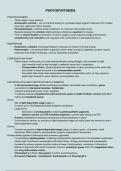Summary
Summary Photosynthesis (part of Module 5, Communication, Homeostasis and Energy)
- Module
- Photosynthesis
- Institution
- OCR
A complete summary of Photosynthesis (part of Module 5) for OCR A A-Level Biology, written by a current medical student who achieved an A* in all 4 A-Levels, including Biology. Condensed to 4 pages, easy to read and very clear layout. Written directly from the official textbook to ensure no inaccur...
[Show more]



